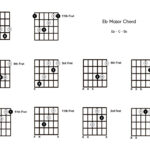Major chords are the cornerstone of guitar playing, often among the first chords beginners learn. They are fundamental building blocks, with countless other chords being extensions or variations of these major and their minor counterparts.
Beyond the basic major chords, you’ll encounter families like major seventh, major ninth, and major thirteenth chords, all rooted in the major sound.
Essential Major Chords for Guitarists
Let’s dive into the must-know major chords. Each diagram below illustrates a common way to play these chords, perfect for starting guitarists.
C Major
Alt text: C Major chord diagram, open position, showing finger placement for beginner guitarists.
D Major
Alt text: D Major chord diagram, open position, illustrating the three-finger shape for guitar.
E Major
Alt text: E Major chord diagram, open position, common six-string voicing for guitar.
F Major
Alt text: F Major chord diagram, barre chord on the first fret, essential shape for guitarists.
G Major
Alt text: G Major chord diagram, open position, widely used G chord shape on guitar.
A Major
Alt text: A Major chord diagram, open position, demonstrating the A major chord fingering on guitar.
B Major
Alt text: B Major chord diagram, barre chord on the second fret, B major shape for guitar.
Practice Makes Perfect: Major Chord Exercises
To solidify your understanding and dexterity with these chords, consider incorporating structured practice.
Major chord exercises (.pdf)
Explore these exercises to train your transitions and chord changes:
1a
1b
2
3
For practical application, delve into the I – IV – V progression, a fundamental chord sequence featuring major chords, presented in all keys with accompanying PDF resources.
Demystifying Major Chord Names
You’ll often see basic major chords written simply with capital letters – C, D, E, and so on. In this context, “C” and “C Major” are interchangeable. Sometimes, you might encounter “CM,” “DM,” “EM,” etc. Pay close attention to the capitalization of “M”; a lowercase “m” signifies a minor chord.
In total, there are twelve unique basic major chords, corresponding to each pitch in Western music. However, due to the standard tuning of the guitar, chords rooted in C#/Db, D#/Eb, F#/Gb, G#/Ab, and A#/Bb can be less straightforward to play in open positions. These are frequently played as barre chords or with a capo to find more comfortable fingerings.
The Triangle Symbol for Major Chords
In older musical notations, particularly jazz charts and lead sheets, “major” might be abbreviated using a delta symbol (triangle). So, a chord name like Câ–³ is equivalent to C major.
Câ–³ (C triangle) = C major
Major Chords with Sharps and Flats
Expanding our palette, let’s look at major chords built on sharp and flat root notes. These are just as major in quality but utilize different root pitches.
C# Major / Db Major
Alt text: C sharp Major chord diagram, barre chord shape, also known as Db Major for guitar.
D# Major / Eb Major
Alt text: D sharp Major chord diagram, barre chord form, or Eb Major for guitarists.
F# Major / Gb Major
Alt text: F sharp Major chord diagram, common barre shape, equivalent to Gb Major on guitar.
G# Major / Ab Major
Alt text: G sharp Major chord diagram, barre chord position, also known as Ab Major for guitar.
A# Major / Bb Major
Alt text: A sharp Major chord diagram, barre chord shape, or Bb Major for guitar players.
The Theory Behind Major Chords
A fundamental major chord is constructed from three distinct musical notes. Given the six strings of a guitar, some of these notes will inevitably be duplicated within a chord voicing. This is simply a consequence of the guitar’s design and tuning. For instance, a G major chord typically uses all six strings, while a D major chord might be voiced using only four strings in certain positions. In the case of the open D major chord, the root note D, serving as the bass note, isn’t readily available on the lower strings in that particular fretboard position.
All major chords are derived from the major scale. Therefore, C major, C major 7th, and related major chords are all based on the C major scale. While this resource doesn’t focus on scales in depth, you can find comprehensive information on sites like GuitarScale.org.
Also, be sure to explore the broader context of Chord progressions to see how major chords function within musical pieces.
Delving Deeper: Notes in Major Chords
Understanding the notes that constitute major chords, and their extended forms, is crucial for music theory knowledge.
Number of Notes in Major Chords
C (Major) 3 notes
Cmaj7 4 notes
Cmaj9 5 notes
Cmaj11 6 notes
Cmaj13 7 notes
Notes in Major 7th Chords
Cmaj7 C – E – G – B
C#maj7 C# – F – G# – C
Dmaj7 D – F# – A – C#
D#maj7 D# – G – A# – D
Emaj7 E – G# – B – D#
Fmaj7 F – A – C – E
F#maj7 F# – A# – C# – F
Gmaj7 G – B – D – F#
G#maj7 G# – C – D# – G
Amaj7 A – C# – E – G#
A#maj7 A# – D – F – A
Bmaj7 B – D# – F# – A#
See diagrams
Notes in Major 9th Chords
Cmaj9 C – E – G – B – D
Dmaj9 D – F# – A – C# – E
Emaj9 E – G# – B – D# – F#
Fmaj9 F – A – C – E – G
Gmaj9 G – B – D – F# – A
Amaj9 A – C# – E – G# – B
Bmaj9 B – D# – F# – A# – C#
See diagrams
Notes in Major 11th Chords
Cmaj11 C – E – G – B – D – F
Dmaj11 D – F# – A – B – E – G
Emaj11 E – G# – B – C# – F# – A
Fmaj11 F – A – C – E – G – Bb
Gmaj11 G – B – D – F# – A – C
Amaj11 A – C# – E – G# – B – D
Bmaj11 B – D# – F# – A# – C# – E
Notes in Major 13th Chords
Cmaj13 C – E – G – B – D – A
Dmaj13 D – F# – A – C# – E – B
Emaj13 E – G# – B – D# – F# – A
Fmaj13 F – A – C – E – G – B
Gmaj13 G – B – D – F# – A – C
Amaj13 A – C# – E – G# – B – D
Bmaj13 B – D# – F# – A# – C# – E
See diagrams
Enhance Your Chord Knowledge
Alt text: Chord Chart Poster thumbnail, showcasing a visual guide to essential guitar chords.
The Chord Chart Poster offers a curated selection of over 100 essential guitar chords.


